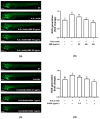Optimized Extraction of Sargahydroquinoic Acid, Major Bioactive Substance, from Sargassum yezoense Using Response Surface Methodology
- PMID: 39728118
- PMCID: PMC11676218
- DOI: 10.3390/md22120543
Optimized Extraction of Sargahydroquinoic Acid, Major Bioactive Substance, from Sargassum yezoense Using Response Surface Methodology
Abstract
Sargahydroquinoic acid (SHQA), a bioactive compound found in certain Sargassum species, exhibits significant health benefits. This study optimized the extraction of SHQA from Sargassum yezoense using response surface methodology (RSM) and evaluated its antioxidant effects through in vitro and in vivo assays. A Box-Behnken design (BBD) was effectively employed to investigate the effects of incubation temperature, time, and ethanol concentration on SHQA yield, achieving a high coefficient of determination (R2 = 0.961). Analysis of variance (ANOVA) validated the model's reliability (F = 13.86, p = 0.005) and highlighted ethanol concentration as a highly significant factor (p < 0.001). Optimal extraction conditions were identified as 52.8 °C, 8.3 h, and 74.1% ethanol. The SHQA-maximized extract (SME) contained 67.8 ± 0.6 mg SHQA/g and 25.00 ± 1.01 mg phloroglucinol equivalent/g. SME exhibited antioxidant capacity of 26.45 ± 0.66 mg and 28.74 ± 2.30 mg vitamin C equivalent/g in ABTS and DPPH assays, respectively, and 0.29 ± 0.02 mM FeSO4 equivalent/g in the FRAP assay. Additionally, SME at 50 µg/mL and SHQA at 1 µg/mL inhibited reactive oxygen species (ROS) generation in an H2O2-induced zebrafish model. This study presents the first optimization of SHQA extraction using RSM and demonstrates SHQA's ROS inhibition in a zebrafish model.
Keywords: Box–Behnken design; Sargassum yezoense; antioxidant; extraction yield; response surface methodology; sargahydroquinoic acid.
Conflict of interest statement
The authors declare no conflicts of interest.
Figures


Similar articles
-
The Role of Sargahydroquinoic Acid and Sargachromenol in the Anti-Inflammatory Effect of Sargassum yezoense.Mar Drugs. 2024 Feb 26;22(3):107. doi: 10.3390/md22030107. Mar Drugs. 2024. PMID: 38535449 Free PMC article.
-
Evaluation of antioxidant activities of various solvent extract from Sargassum serratifolium and its major antioxidant components.Food Chem. 2019 Apr 25;278:178-184. doi: 10.1016/j.foodchem.2018.11.058. Epub 2018 Nov 10. Food Chem. 2019. PMID: 30583359
-
Sargahydroquinoic acid isolated from Sargassum serratifolium as inhibitor of cellular basophils activation and passive cutaneous anaphylaxis in mice.Int Immunopharmacol. 2022 Apr;105:108567. doi: 10.1016/j.intimp.2022.108567. Epub 2022 Feb 1. Int Immunopharmacol. 2022. PMID: 35114442
-
Optimization of ultrasound-assisted extraction of phenolic content & antioxidant activity of hog plum (Spondias pinnata L. f. kurz) pulp by response surface methodology.Heliyon. 2022 Oct 14;8(10):e11109. doi: 10.1016/j.heliyon.2022.e11109. eCollection 2022 Oct. Heliyon. 2022. PMID: 36281389 Free PMC article.
-
Sargahydroquinoic Acid, a Cyclooxygenase-2 Inhibitor, Attenuates Inflammatory Responses by Regulating NF-κB Inactivation and Nrf2 Activation in Lipopolysaccharide-Stimulated Cells.Inflammation. 2021 Oct;44(5):2120-2131. doi: 10.1007/s10753-021-01488-x. Epub 2021 May 29. Inflammation. 2021. PMID: 34050497
References
-
- Yong W.T.L., Thien V.Y., Misson M., Chin G.J.W.L., Hussin S.N.I.S., Chong H.L.H., Yusof N.A., Ma N.L., Rodrigues K.F. Seaweed: A bioindustrial game-changer for the green revolution. Biomass Bioenergy. 2024;183:107122. doi: 10.1016/j.biombioe.2024.107122. - DOI
-
- Cao L., Lee B., Lee B.-H., Lee S., Kim H.-R. Sargahydroquinoic acid from Sargassum macrocarpum attenuates TNF-α and UV-induced skin aging in human dermal fibroblasts. Algal Res. 2024;78:103410. doi: 10.1016/j.algal.2024.103410. - DOI
MeSH terms
Substances
Grants and funding
- RS-2024-00404977/This research was supported by a grant of Korea Institute of Marine Science & Technology Pro-motion (KIMST) funded by the Ministry of Oceans and Fisheries, Republic of Korea
- 2023RIS-007/Regional Innovation Strategy (RIS)" through the National Research Foundation of Korea (NRF) funded by the Ministry of Education (MOE)
LinkOut - more resources
Full Text Sources
Medical
Miscellaneous

